

Sikh holidays are commemorative occasions celebrated with worship and festivities such as parades. The Guru Granth Sahib, Sikhism’s scripture, is carried through the streets on a palanquin or float in a musical procession known as nagar kirtan, which involves devotional singing. The panj pyara, or five beloved ones, march ahead of the worshipers. There may be floats representing scenes from history or carrying devotees. Many times there will be martial arts demonstrations known as gatka. Traditionally, langar, free food and drink, is available along the parade, route or served at its conclusion.
Sikh celebrations commemorate important events throughout Sikh history. Sikhism dates back to 1469 AD and has its origins in 15th century Punjab. Obscure records dated according to lunar calendars of Punjab, in use centuries ago, are transcribed to coincide with modern solar Indian calendars and adapted to the Western Gregorian calendar. Dates differ with each succeeding year and can result in confusion. The Nanakshahi calendar developed in the 20th century corresponds to the names of months which appear in the Guru Granth Sahib Commemorative events are fixed to the standardized Western calendar so that they may be celebrated around the world on the same date year after year. Even so, celebrations may occur weeks preceding the given date.
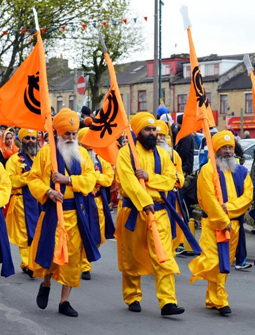
Vaisakhi is an annual celebration which originated in April of 1699. Vaisakhi commemorates the anniversary of when Guru Gobind Singh formalized membership into the Sikh religion with initiation rites. The Guru called for volunteers willing to give their heads. The five who came forward are known as the Panj Pyare, or five beloved ones. The Panj pyare conduct the initiation ceremony known as Amritsanchar. Initiates drink Amrit, an immortalizing nectar. Commemorative services may include the retelling of the event, narration of battles fought by Guru Gobind Singh, devotional singing, nagar kirtan parades, and Amrit initiation ceremonies.
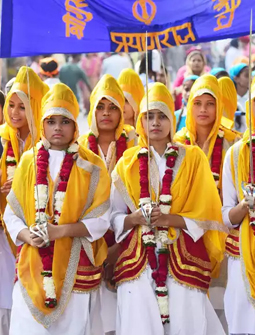
The Panj pyara are representatives of the historical five beloved administrators of Amrit. All important Sikh celebrations and festivities are carried out with the panj pyara in attendance. On many occasions, especially parades there may be several groups of five Sikhs in attendance. The panj pyara traditionally wear saffron colored cholas, carry swords, and walk at the head of a procession. Other groups of five may carry State and Federal flags, Nishan Sahib Sikh flags, or banners, and may wear (as a group), saffron yellow, bright orange, blue, or white.
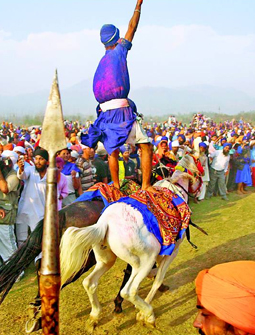
The annual event of Hola Mohalla is a martial arts parade historically coinciding with Holi, the Hindu festival of colors which occurs in March. Hola Mohalla celebrations in the Punjab traditionally take place for up to a week with a parade occurring on the final day. Festivities include demonstrations and displays of skill involving Gatka, the Sikh martial arts swordplay, and may include other feats such as horsemanship. In the USA, Hola Mohalla takes the form of nagar kirtan parades with demonstrations of gatka, the Sikh martial art. These events may be held in various locations over several weekends preceding the actual date of the holiday.
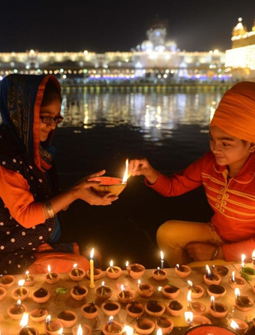
Bandi Chhor is a commemorative occasion having no fixed date which occurs in October or November and celebrates the release of Sixth Guru Har Govind from imprisonment. The event historically coincides with Diwali, the Hindu festival of lamps. Sikhs celebrate Bandi Chhor with worship services which include kirtan or devotional singing, and possibly lighting of lamps or candles.
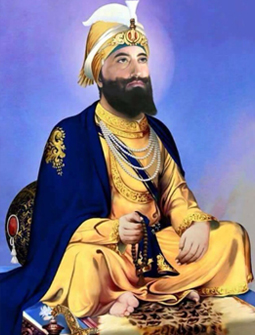
Each of the ten gurus or spiritual masters of Sikhism were inaugurated by turn. Guru Gadee Divas is a festivity celebrating the inauguration of the Guru Granth Sahib as the everlasting Guru of the Sikhs on October 20, 1708. Guru Gadee is celebrated as an annual event in late October through early November. Sikh devotees parade the Guru Granth Sahib through the streets atop floats or carried on their shoulders in a palanquin.
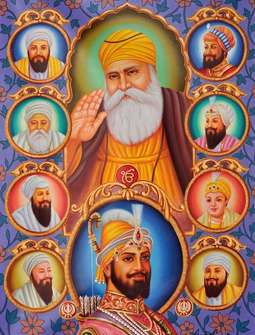
Gurpurab is the commemoration of the anniversary of important events in each of the ten guru's lives which include:
Such occasions are observed with worship services and devotional singing.
Guru Nanak's gurpurab is celebrated during pooran mashi, the full moon, in late November or early December. This festive occasion often lasts several days and nights, and may include:
Guru Gobind Singh's Birth and the shaheed or martyrdom, of his four sons, are observed during winter holidays in late December with Rainsabaee kirtan all night worship service.
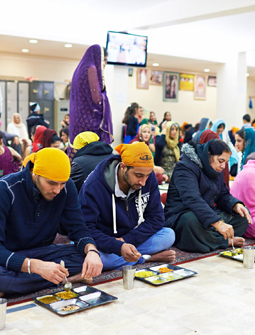
Langar, the service of free vegetarian food and drink, is an element connected with each and every Sikh occasion and event, whether a worship service, ceremony, celebration or festivity. Traditionally langar is cooked in the gurdwara free kitchen and served in the dining hall. However, during a parade, langar may be distributed in any number of ways. Sikh devotees may hand out offerings of specially prepared foods or give out prepackaged snacks and drinks along the parade route.